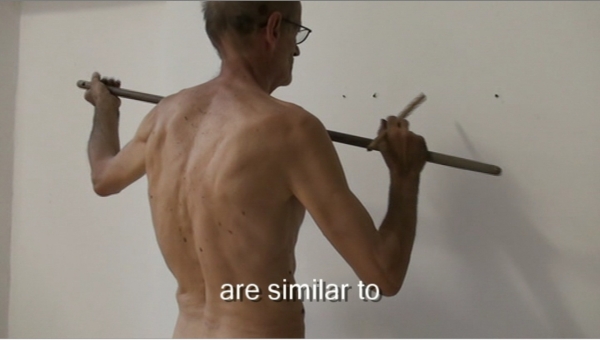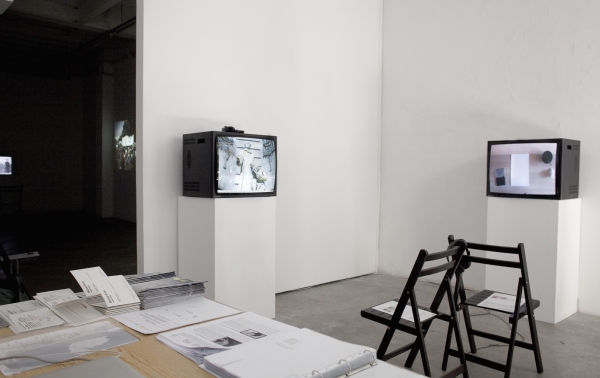Oliver Ressler, Jeanno Gaussi, Ion Grigorescu, Harun Farocki, Firas Shehadeh, Daniela Ortiz
Body Politics
28.05.15 > 06.06.15

Harun Farocki: Their Newspapers, 1968 16 mm film transferred to digital file, B/W, sound, 17’ The full title of this film is: Some problems of antiauthoritarian and anti-imperialist urban warfare in the case of West Berlin or Their Newspapers. This is one of Farocki’s first works, in which the artist himself appears as an actor, and is considered part of the German agitprop student movement against the powerful Springer media group, which controlled major newspapers like Bild Zeitung and Berliner Zeitung. As a fictional documentary, the bombs dropped in the Vietnam War are compared here with the manipulation of the media. In order to show that these newspapers were taking control of public opinion, they took the streets and demonstrated at their headquarters. These events generated considerable stir in the German collective consciousness.
18_4552.jpg)
Jeanno Gaussi: Three Fragments from Jerusalem, 2010 Video, color, no sound. 6’ 20” Three Fragments of Jerusalem is Jeanno Gaussi’s reflection of Jerusalem in relation to the project Home Sweet Home-Jerusalem, a multi-city art project that the artist initiated in 2009 in Shatana, Jordan with Youmna Chlala from Beirut. The project examines the contemporary definition of emptiness and belonging, and expands these notions into places that mark new forms of emptiness in contemporary culture. The final part of this project Post Home Space, which includes a reflective text and video work by each artist, constitutes the physical distancing from home, where memory becomes selective a fragmented image of home emerges. As the artist explains, “the post home space then becomes a container of real and imagined experience.” Gaussi’s Post Home reflection centers around three objects that surrounded her during her days alone at the house she stayed at in Jerusalem.

Ion Grigorescu: Drawing?, 2014 Video, subtext, color, sound. 8’33” Ion Grigorescu uses his own body as subject by filming himself nude, while performing the act of creating a drawing. He is performing because he creates no drawing, as his “writing tool” is merely a wooden stick that leaves no mark. He does not speak, but his movements are accompanied by a poetic subtext in which he expresses his relationship to the drawing process. Comparing drawing to hunting, this is, for Grigorescu, a political relationship: it demands that the illustrator or artist appropriate his surroundings. In line with his body of work, in which a poverty of materials is often present, his nakedness represents redemption from those surroundings through the absence of the social symbols clothing inevitably carries. The result is the impression that this act occurs outside of time and space.

Daniela Ortiz: Réplica, 2014 Video, colour, sound. 4’ 29” In Réplica, the artist kneels before the Spaniards gathered at Plaza Cataluña to celebrate the Fiesta Nacional de España (the National Day of Spain) on the 12th of October 2014. She reproduces the position of an indigenous person kneeled before Bernardo Boyl (priest who accompanied Cristopher Columbus on his 2nd trip to America), as depicted in the monument dedicated to Christopher Columbus in Barcelona with the objective of making the Spaniards reflect on their history of colonization and the symbolism found in the monuments that surround us.

Oliver Ressler: Take the square, 2012 3-channel video installation, 88’ (25’ 53” Atenas - 34’ Madrid - 28’ 51” New York) The 3-channel video installation Take The Square is based on discussions conducted with activists from 15M in Madrid, the Syntagma Square movement in Athens and Occupy Wall Street in New York. Re-enacting the format of the working groups of the protest movements, four to six activists discuss with each other as a group in front of a camera. The discussions cover issues of organization, horizontal decision-making processes, the importance and function of occupying public spaces and how social change can occur. Take The Square is trying to contribute to spreading the organizational knowledge of the movements and translate the processes between these places in transition.

Firas Shehadeh: Unidentified, 2014 Single channel video, sound, color installation, and a series of 3 fingerprints photocopies In Unidentified Shehadeh reflects on the uses of biometrics (measurement systems related to human characteristics and traits used to identify individuals) applied to groups that are under surveillance. Fingerprint identification is one of the most widely biometric data systems used for law enforcement and to establish control over immigration. Biometric technologies are the biopolitical dimension of bodies. Eurodac is a supranational cyber network, a EU database and the first common identification system automated fingerprint within the European Union. In the video, Firas, as a Palestinian refugee himself, seeks to answer the question: “How can I create a virtual image of my illegible body, not computable, inaccessible and biometrically unprocessable?; and the answer comes from what refugees are already doing at borders in order to have freedom of movement, defacing, scorching, cutting and burning their fingers or their fingerprints.”


Réplica, Daniela Ortiz, and Unidentified, Firas Shehadeh. Exhibition views, espai2.

Take the square, Oliver Ressler. Exhibition view.

Drawing?, Ion Grigorescu. Exhibition view.